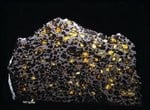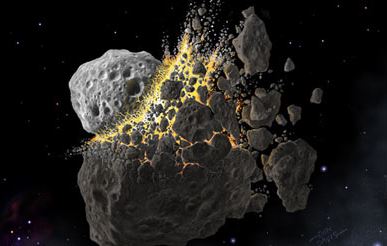Meteorites contain hidden magnetic messages from the early solar system, scientists at the University of Cambridge reported in the journal Nature. The meteorites’ magnetism was measured at BESSY II, a research establishment in the Adlershof district of Berlin, Germany.
A geological team, led by Dr. Richard Harrison, has captured data stored within tiny magnetic regions of meteorite samples using the PEEM-Beamline at BESSY II.
According to the geologists “This information captures the dying moments of the magnetic field during core solidification on a meteorite parent body, providing a sneak preview of the fate of Earth’s own magnetic field as its core continues to freeze.”
Scientist have always thought meteorites had poor magnetic memories, because the magnet signals they carried would have been re-written several times during the long journey to Earth.

The hidden magnetic messages held within ancient meteorites are providing scientists a unique window into the processes that shaped our solar system. They may also give us a sneak preview of the fate of our planet’s core as it continues to freeze. (Image: University of Cambridge)
Dr. Harrison and team identified specific regions filled with nanoparticles that were magnetically very stable. These “tiny space magnets” hold a reliable record of the magnetic fields generated by the parent body of the meteorite.
At BESSY II, the scientists were able to map these tiny magnet signals using circular polarized X-ray synchrotron radiation.
Meteorites, which are fragments of asteroids formed about 4.5 billion years ago (during the early solar system), have witnessed a long and violent history. Shortly after being formed, some asteroids were heated up by radioactive decay. They melted and segregated into a liquid metal core surrounded by a solid rocky mantle.
Magnetic fields were created by convection of the liquid, just as the Earth’s outer core liquid generates a magnetic field today.
Occasionally, asteroids crash into each other and tiny fragments fall to earth as meteorites, giving researchers the chance to study the properties of magnetic fields that were generated several billions of years ago.
Dr. Harrison said “They are like natural hard discs.” He and his colleagues have been searching for ways to decipher the data stored deep inside the meteorites. His new approach appears to have yielded its first results.
Scientists have doubted whether ancient magnetic signals could be stored in stony-iron meteorites. “Large and highly mobile magnetic domains are found within the iron metal: these domains create huge magnetic signals but are easily overwritten by new events. The probability that these regions might contain useful information about early magnetic fields in the solar system is extremely low,” they explained.
However, Dr. Harrison took a much closer look. At BESSY II’s PEEM-Beamline, Dr. Harrison and James Bryson, a PhD student, found dramatic variations in magnetic properties as they went through the meteorite.
Not only did they see regions containing large, mobile magnetic domains, but also identified the “cloudy zone”, an unusual region containing thousands of tiny particles of tetrataenite, a native metal found in meteorites with the composition FeNi (a super hard magnetic material). Tetrataenite is magnetically much more stable than the rest of the meteorite.
Mr. Bryson said:
“These tiny particles, just 50 to 100 nanometers in diameter, hold on to their magnetic signal and don’t change. So it is only these very small regions of chaotic looking magnetization that contain the information we want.”
The PEEM-Beamline offers X-rays with the precise energy and polarization required to make sense of these magnetic fields. Since the absorption of the X-rays relies on magnetization, the researchers could map the magnetic signals on the sample surface in ultra-high resolution, without the procedure altering them.
Dr. Harrison pointed out:
“The new technique we have developed is a way of analyzing these images to extract real information. So we can do for the first time paleomagnetic measurements of very small regions of these rocks, regions which are less than one micrometer in size. These are the highest resolution paleomagnetic measurements ever made.”
The team spatially resolved the variations in magnetic signals across the cloudy zone, and were thus able to reconstruct the history of magnetic activity of the meteorite parent body. They even managed to capture the exact moment when the core finished solidifying and the magnetic field shut down.
Their findings answer several open questions concerning the longevity and stability of magnetic activity in small bodies.
Their observations, backed by computer simulations, showed that the magnetic field was created by compositional, and not thermal, convection – “a result that changes our perspective on the way magnetic fields were generated during the early solar system and even provides a sneak preview of the fate of Earth’s own magnetic field as its core continues to freeze,” they wrote.
Citation: “Long-lived magnetism from solidification-driven convection on the pallasite parent body,” James F. J. Bryson, Claire I. O. Nichols, Julia Herrero-Albillos, Florian Kronast, Takeshi Kasama, Hossein Alimadadi, Gerrit van der Laan, Francis Nimmo & Richard J. Harrison. Nature 517, 472–475 (22 January 2015). doi:10.1038/nature14114.


